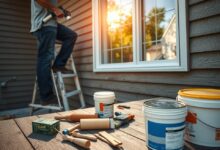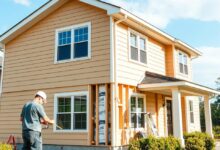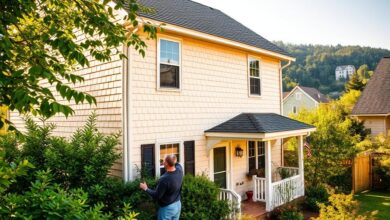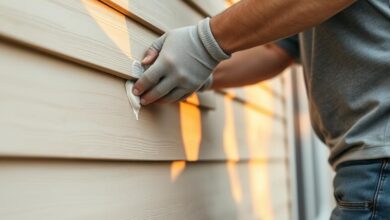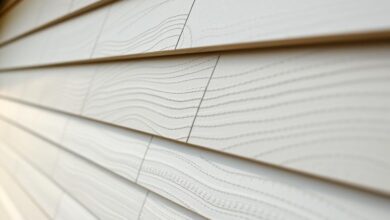Insulated Siding: Unlock the Benefits for Your Home
Homeowners in the United States are always looking for ways to make their homes better. They want them to be more energy-efficient and cost-effective. Insulated siding is becoming popular because it makes your home look better and protects it from the weather.
Installing insulated siding means you can live more comfortably. You’ll also save money on energy bills and increase your home’s value. This is part of a bigger trend in home improvement that focuses on saving energy and being green.
Key Takeaways
- Insulated siding enhances home exterior and provides protection
- Improves energy efficiency and reduces bills
- Increases property value
- Part of the broader home improvement trend
- Contributes to a more comfortable living space
What Is Insulated Siding and How Does It Work?
Insulated siding is a new way to cover your home’s exterior. It’s strong and saves energy. Homeowners like it because it makes their homes look better and saves money on bills.
The Structure and Components of Insulated Siding
Insulated siding has several layers. It has a structural substrate, a foam core, and an outer cladding. These parts work together to make a strong, energy-saving option. Here’s what each part does:
| Component | Description |
|---|---|
| Exterior Cladding | Durable material resistant to weathering |
| Foam Insulation Core | Provides thermal insulation, reducing heat transfer |
| Structural Substrate | Supports the siding and provides additional strength |
The Science Behind Thermal Insulation in Siding
The thermal insulation in insulated siding stops heat from moving in and out. The foam core blocks heat in three ways: convection, conduction, and radiation. This makes your home more energy-efficient. , it helps save on energy bills and makes your home more comfortable.
How well insulated siding works is shown by its R-value. A higher R-value means better insulation. This is important for keeping your home warm in winter and cool in summer.
Benefits of Insulated Siding for American Homeowners
Insulated siding is great for homeowners who want to make their homes more energy efficient and durable. It adds insulation, which keeps homes warm in winter and cool in summer. This makes living there more comfortable.
Enhanced Energy Efficiency and Reduced Utility Costs
Insulated siding boosts energy efficiency. It stops heat from escaping, saving on heating bills in winter. In summer, it keeps homes cooler, cutting down on air conditioning costs.
This not only cuts down on utility bills but also helps the environment. It makes homes use less energy overall.
Improved Noise Reduction Properties
Insulated siding also reduces noise. Its insulation layer blocks out external sounds, making homes quieter. This is great for homes near busy roads or in noisy areas.
Added Structural Integrity and Impact Resistance
Insulated siding also makes homes stronger and more impact resistant. The extra material adds strength, protecting against wind, rain, and other damage. This means the siding lasts longer and needs less maintenance.
Choosing insulated siding brings many benefits. It improves comfort, efficiency, and the value of your home.
Types of Insulated Siding Products on the Market
Insulated siding comes in many types, like vinyl and fiber cement. Each has its own benefits, such as saving energy, lasting longer, and looking good. Homeowners can pick the best one for their needs.
Vinyl Insulated Siding Options
Vinyl insulated siding is loved for being affordable and easy to put up. It’s strong like vinyl but also saves energy. The R-value, which shows how well it keeps heat out, varies among products. Some also resist fading and cracking.
Fiber Cement Insulated Panels
Fiber cement insulated panels are durable and fire-safe. They’re made from cement, sand, and cellulose fibers. This mix gives them strength. Adding insulation makes them even better at saving energy and keeping a classic look.
Foam Backed vs. Integrated Insulation Systems
Insulation can be added in two ways. Foam-backed siding has foam on the back, while integrated insulation systems have it built into the siding. Foam-backed is simpler to install, but integrated might have a higher R-value.
R-Value Comparisons Between Products
The R-value is key when picking siding. It shows how well the siding keeps heat out. Vinyl can have an R-value as low as R-2, while advanced systems can reach R-5 or more. Think about your climate and energy goals when choosing.
Installation Process and Considerations
The success of insulated siding depends on the installation process and preparation. Homeowners need to make informed choices for a smooth installation.
Professional Installation vs. DIY Approach
Homeowners must decide between professional installation and a DIY approach. Professional installation ensures the siding is done right, maximizing benefits. Experts have the skills and tools to tackle any installation challenges.
DIY installation, while cheaper, requires a lot of time and effort. It’s important to be sure you can follow the manufacturer’s instructions and handle any surprises. Also, check the warranty, as some may require professional installation to be valid.
Preparation Requirements for Your Home
Before starting, several preparation steps are needed. This includes removing old siding, checking and fixing damaged sheathing, and cleaning the exterior. Make sure to get all necessary permits before starting.
It’s also key to protect your landscaping and outdoor items. Cover plants, move outdoor furniture, and secure loose items to avoid damage during installation.
Typical Installation Timeline and Process
The installation timeline varies based on the home’s size and job complexity. The process involves measuring, cutting siding, and securing it to the home. Professionals ensure the siding fits right and seals all seams to prevent moisture.

Understanding the installation process and considerations is key to getting the most from insulated siding. By choosing the right method and preparing well, homeowners can enjoy better energy efficiency, durability, and looks.
Cost Analysis and Long-Term Value
Insulated siding’s cost goes beyond the first payment. Homeowners need to think about siding type, installation costs, and long-term savings.
Initial Investment Compared to Traditional Siding
Insulated siding costs more upfront than traditional siding. But, its energy efficiency and durability save money over time. It keeps your home cooler in summer and warmer in winter, cutting down on utility bills.
| Siding Type | Initial Cost | Energy Savings |
|---|---|---|
| Insulated Vinyl Siding | $10-$15 per sqft | Up to 20% |
| Traditional Vinyl Siding | $6-$10 per sqft | N/A |
| Fiber Cement Insulated Siding | $12-$18 per sqft | Up to 25% |
Maintenance Requirements and Costs
Insulated siding needs less upkeep than traditional siding. It stands up well to weather, cutting down on repair or replacement needs. Regular cleaning keeps it looking good and working well.
Energy Savings and Return on Investment
Insulated siding’s big plus is its energy savings. It keeps your home’s temperature steady, reducing heating and cooling needs. This can save a lot of money over time.
Tax Incentives and Rebates for Energy Efficient Upgrades
Installing energy-efficient upgrades like insulated siding might get you tax breaks and rebates. These can help lower the initial cost, making it more appealing.
In summary, insulated siding’s higher initial cost is worth it for its long-term benefits. It saves on energy and needs less upkeep. Homeowners should weigh these points when looking at insulated siding’s cost.
Conclusion: Making the Right Choice for Your Home
Choosing insulated siding for your home is a big decision. It’s important to know the benefits and options. Insulated siding can make your home more energy-efficient and save you money on utilities.
It also helps reduce noise and adds strength to your home. By looking at different types of insulated siding, like vinyl and fiber cement, you can find the best fit for your home and budget. Even though it might cost more upfront, the long-term savings and less maintenance can be worth it.
Choosing the right insulated siding means looking at both the benefits and costs. With the right choice, your home will be more comfortable, save energy, and last longer. This can also increase your home’s value.



